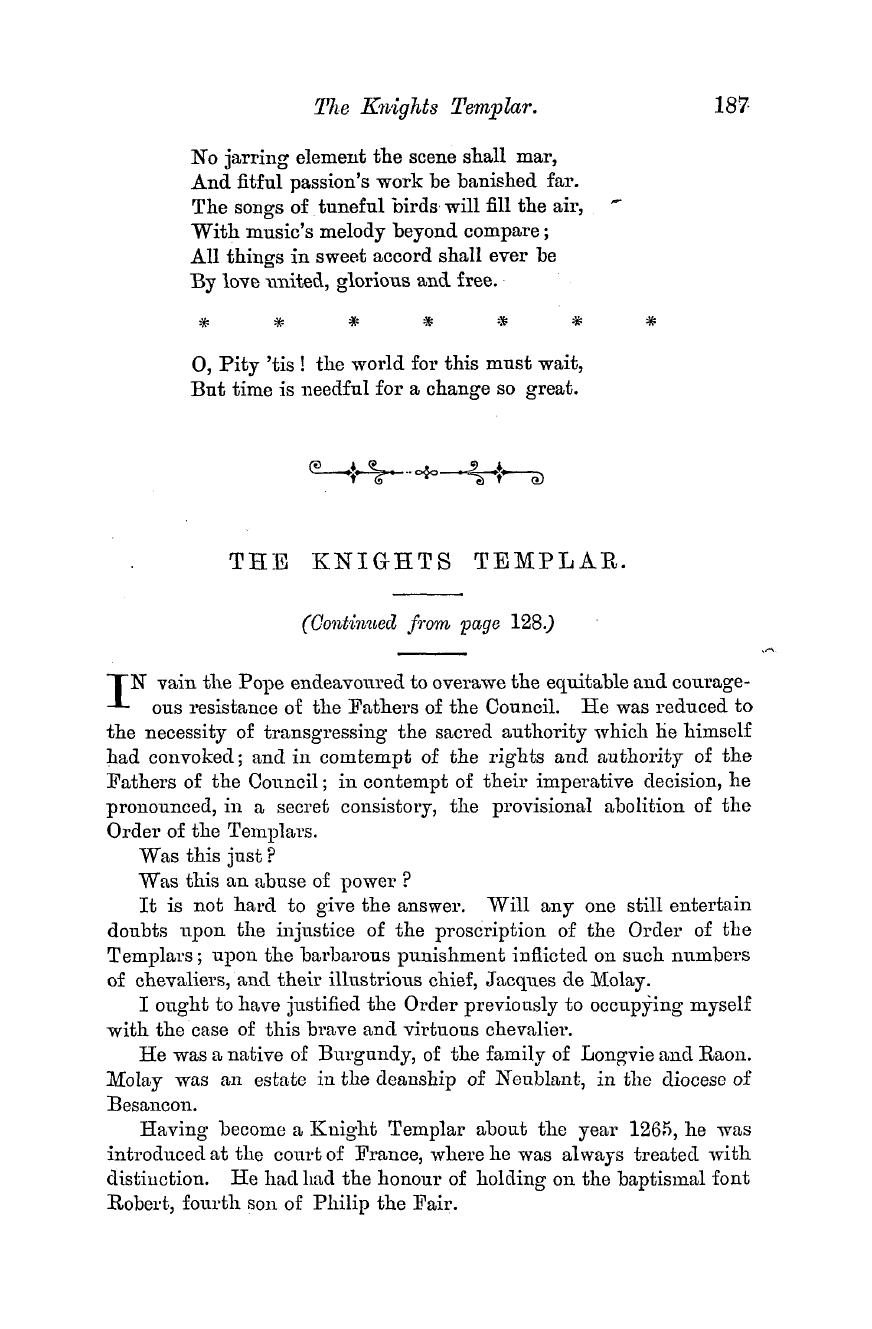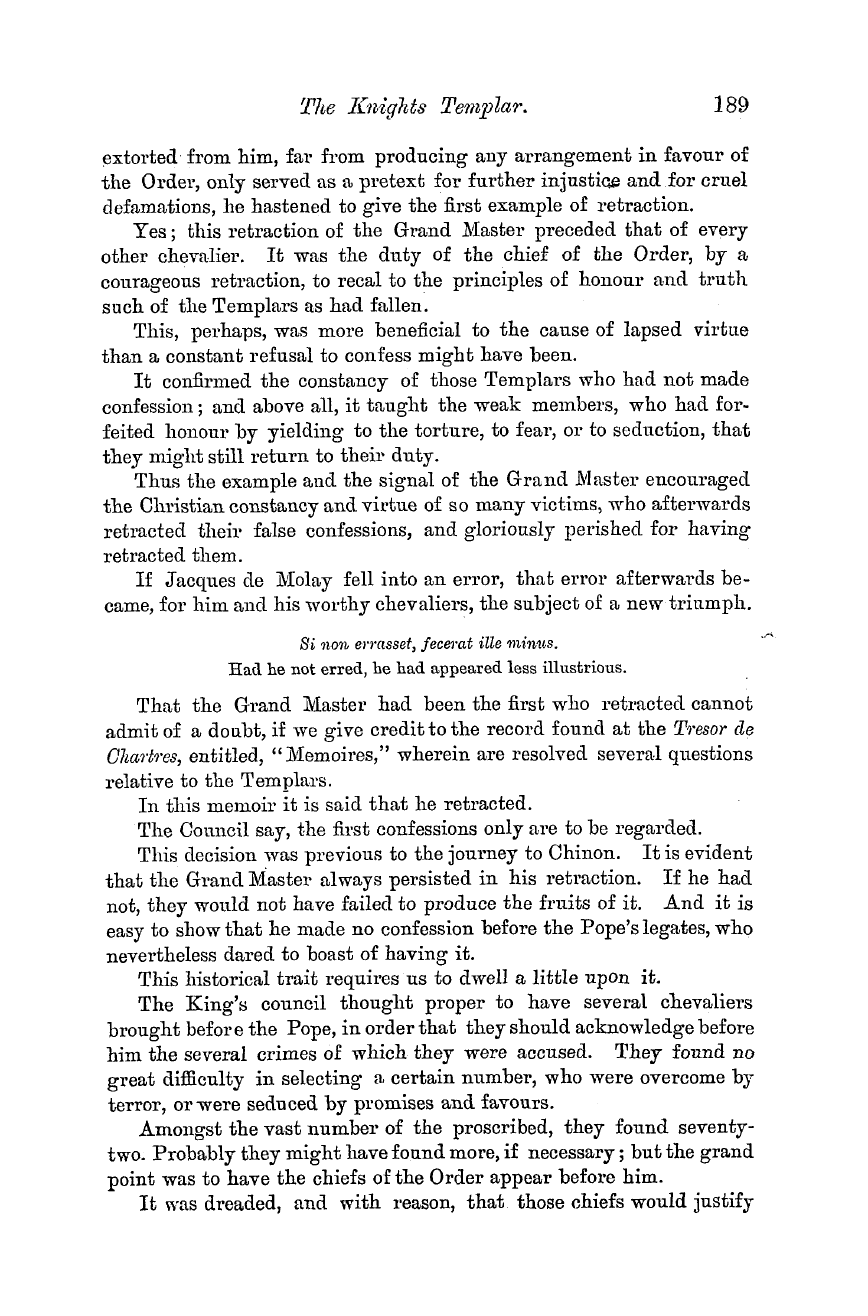-
Articles/Ads
Article THE KNIGHTS TEMPLAR. ← Page 3 of 6 →
Note: This text has been automatically extracted via Optical Character Recognition (OCR) software.
The Knights Templar.
extorted from him , far from producing any arrangement in favour of the Order , only served as a pretext for further injustice and for cruel defamations , he hastened to give the first example of retraction . Yes ; this retraction of the Grand Master preceded that of every
other cheA alier . It was the duty of the chief of the Order , by a courageous retraction , to recal to the principles of honour and truth such of the Templars as had fallen . This , perhaps , was more beneficial to the cause of lapsed virtue than a constant refusal to confess might have been .
It confirmed the constancy of those Templars who had not made confession ; and above all , it taught the weak members , who had forfeited honour by yielding to the torture , to fear , or to seduction , that they might still return to their duty . Thus the example and the signal of the Grand Master encouraged
the Christian constancy and virtue of so many victims , who afterwards retracted their false confessions , and gloriously perished for having retracted them . If Jacques de Molay fell into an error , that error afterwards became , for him and his worthy chevaliers , the subject of a new triumph .
Si non errasset , fecerat Me minus . Had he not erred , he had appeared less illustrious . That the Grand Master had been the first who retracted cannot admit of a doubt , if Ave g ive credit to the record found at the Tresor de
Chartres , entitled , "Memoires , " wherein are resolved several questions relative to the Templars . In this memoir it is said that he retracted . The Council say , the first confessions only are to be regarded . This decision was previous to the journey to Chinon . It is evident
that the Grand Master always persisted in his retraction . If he had not , they would not have failed to produce the fruits of it . And it is easy to show that he made no confession before the Pope ' s legates , who nevertheless dared to boast of having it . This historical trait requires us to dAvell a little upon it .
The King ' s council thought proper to have several chevaliers brought before the Pope , in order that they should acknOAvledge before him the several crimes of which they were accused . They found no great difficulty in selecting a certain number , who were overcome by terror , or were seduced by promises and favours .
Amongst the vast number of the proscribed , they found seventytwo . Probably they mig ht have found more , if necessary ; but the grand point was to have the chiefs of the Order appear before him . It was dreaded , and with reason , that those chiefs would justify
Note: This text has been automatically extracted via Optical Character Recognition (OCR) software.
The Knights Templar.
extorted from him , far from producing any arrangement in favour of the Order , only served as a pretext for further injustice and for cruel defamations , he hastened to give the first example of retraction . Yes ; this retraction of the Grand Master preceded that of every
other cheA alier . It was the duty of the chief of the Order , by a courageous retraction , to recal to the principles of honour and truth such of the Templars as had fallen . This , perhaps , was more beneficial to the cause of lapsed virtue than a constant refusal to confess might have been .
It confirmed the constancy of those Templars who had not made confession ; and above all , it taught the weak members , who had forfeited honour by yielding to the torture , to fear , or to seduction , that they might still return to their duty . Thus the example and the signal of the Grand Master encouraged
the Christian constancy and virtue of so many victims , who afterwards retracted their false confessions , and gloriously perished for having retracted them . If Jacques de Molay fell into an error , that error afterwards became , for him and his worthy chevaliers , the subject of a new triumph .
Si non errasset , fecerat Me minus . Had he not erred , he had appeared less illustrious . That the Grand Master had been the first who retracted cannot admit of a doubt , if Ave g ive credit to the record found at the Tresor de
Chartres , entitled , "Memoires , " wherein are resolved several questions relative to the Templars . In this memoir it is said that he retracted . The Council say , the first confessions only are to be regarded . This decision was previous to the journey to Chinon . It is evident
that the Grand Master always persisted in his retraction . If he had not , they would not have failed to produce the fruits of it . And it is easy to show that he made no confession before the Pope ' s legates , who nevertheless dared to boast of having it . This historical trait requires us to dAvell a little upon it .
The King ' s council thought proper to have several chevaliers brought before the Pope , in order that they should acknOAvledge before him the several crimes of which they were accused . They found no great difficulty in selecting a certain number , who were overcome by terror , or were seduced by promises and favours .
Amongst the vast number of the proscribed , they found seventytwo . Probably they mig ht have found more , if necessary ; but the grand point was to have the chiefs of the Order appear before him . It was dreaded , and with reason , that those chiefs would justify































































